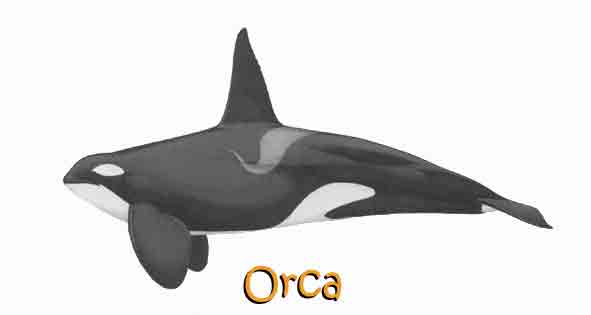
Habitat and Distribution | Physical Appearance | Behavior | Breeding and Reproduction | Diet | Fun Facts
 Lots More: Sounds, Videos, Etcetera on Marine Mammals Lots More: Sounds, Videos, Etcetera on Marine Mammals
Habitat and Distribution
Orcas (scientific name: Orcinus orca), also known as killer whales,
live in all oceans of the world. These mammals prefer to live in cooler waters, especially the polar regions,
with the largest populations found in the Arctic and Antarctica. It has been estimated that 160,000 orcas
inhabit the waters surrounding the continent of Antarctica. In addition to these areas, orcas can be found in
the Western Mediterranean, the Arabian Sea and the Gulf of Aden. Orcas prefer coastal areas, and are almost always seen within 500 miles (800km)
of the shoreline. They are occasionally even sighted in close proximity to the shore, such as the surf zone, shallow bays, inland seas, and
estuaries. They migrate from place to place depending on food availability and ice formation in the freezing waters.
Back to the top
Physical Appearance
Orcas are the largest member of the dolphin family. The head of this marine mammal is
conical in shape. Orcas have 10 - 12 large conical curved teeth on each side of their jaw, along with powerful mouth muscles to help with prey capture.
Color: Orcas have a very distinct jet-black body with white patches over the eyes,
under the jaw, on the belly, and on either side of the body. They also have a gray saddle-shaped patch
behind their dorsal fin. This coloration is thought to create camouflage. Their dark back blends in with
the water below, while the light belly blends in with the light above entering the ocean. This
camouflage, called countershading, may help orcas to sneak up on unsuspecting prey.
Length and weight: Female orcas grow between 16 - 23 feet (4.9 - 7 meters) in length,
and weigh between 3,000 and 8,000 pounds (1,375 and 3,600 kg). Males are larger, with lengths of 23 - 36
feet (7 - 11 meters) and weighing between 8,000 and 12,000 pounds (3,600 and 5,500 kg).
Fins: Orcas have a very distinctive jet-black dorsal fin.This dorsal fin can be
as large as 3 feet (0.9 meter) in females, and 6 feet (1.8 meters) in males.
Back to the top
Behavior
Orcas form pods mixed with males, females and calves. An orca's pod is a close family group that
contains members that usually stay together for life. When two or more pods come together these groups are
called "superpods". Superpods can contain more than 150 individuals.
Studies on orcas have shown these mammals belong to one of two types -
a "transient' group or "resident" group. Transient groups form smaller pods of 1 - 7 individuals and roam over
large oceanic areas. In addition, this group feeds mainly on mammals, vocalizes less frequently and stays underwater for
5 to 15 minutes at a time. Transients also have a more pointed dorsal fin located on the center of their backs.
Residents, on the other hand, form larger pods made up of 5 - 25 individuals, roam in a smaller home area, and
feed dominantly on fish. This group also tends to vocalize more often and stay underwater for shorter time
periods (less than 4 minutes at a time).
Back to the top
Breeding and Reproduction
Male orcas reach sexual maturity when they reach about 22 feet (6.7 meters) long, or between the
ages of 12 and 16 years. Females reach sexual maturity at around 16 feet (4.9 meters) in length, or between the ages
of 6 to 10 years. Orcas breed mainly in the winter and early spring. Females are pregnant for approximately
17 months before they give birth. Females typically give birth every 3 to 10 years. When a baby orca is
born, it is about 6.5 to 8 feet (2 to 2.5 meters) in length, and may weigh up to 400 pounds (180 kg).
Now that's a big baby!
Back to the top
Diet
Orcas have one of the most diverse diets of all marine mammals.
They have been known to eat birds, sea turtles, penguins, seals, porpoises, and large
baleen whales. More commonly, orcas can be seen eating fish such as salmon and cod, and squid. An
orca's diet is largely dependent on where the animal lives and what food is available in that environment.
Back to the top
Fun Facts
- Orcas are the largest member of the dolphin family.
- Oras are among the fastest swimming marine mammals, reaching speeds of up to 30
miles (48 km) per hour. In the wild, you will typically see orcas swimming at a much slower pace, averaging
2 to 6 miles (3.2 to 10 km) per hour.
- At a distance, female and juvenile orcas have been known to be confused with the Risso's dolphins and Dall's porpoises.
- The dorsal fin of a male orca can stand up to 6 feet (1.8 meters) tall.
- Adult orcas eat 100 - 300 pounds (45 - 135 kg) of food each day.
Back to the top
 Lots More: Sounds, Videos, Etcetera on Marine Mammals Lots More: Sounds, Videos, Etcetera on Marine Mammals
|

